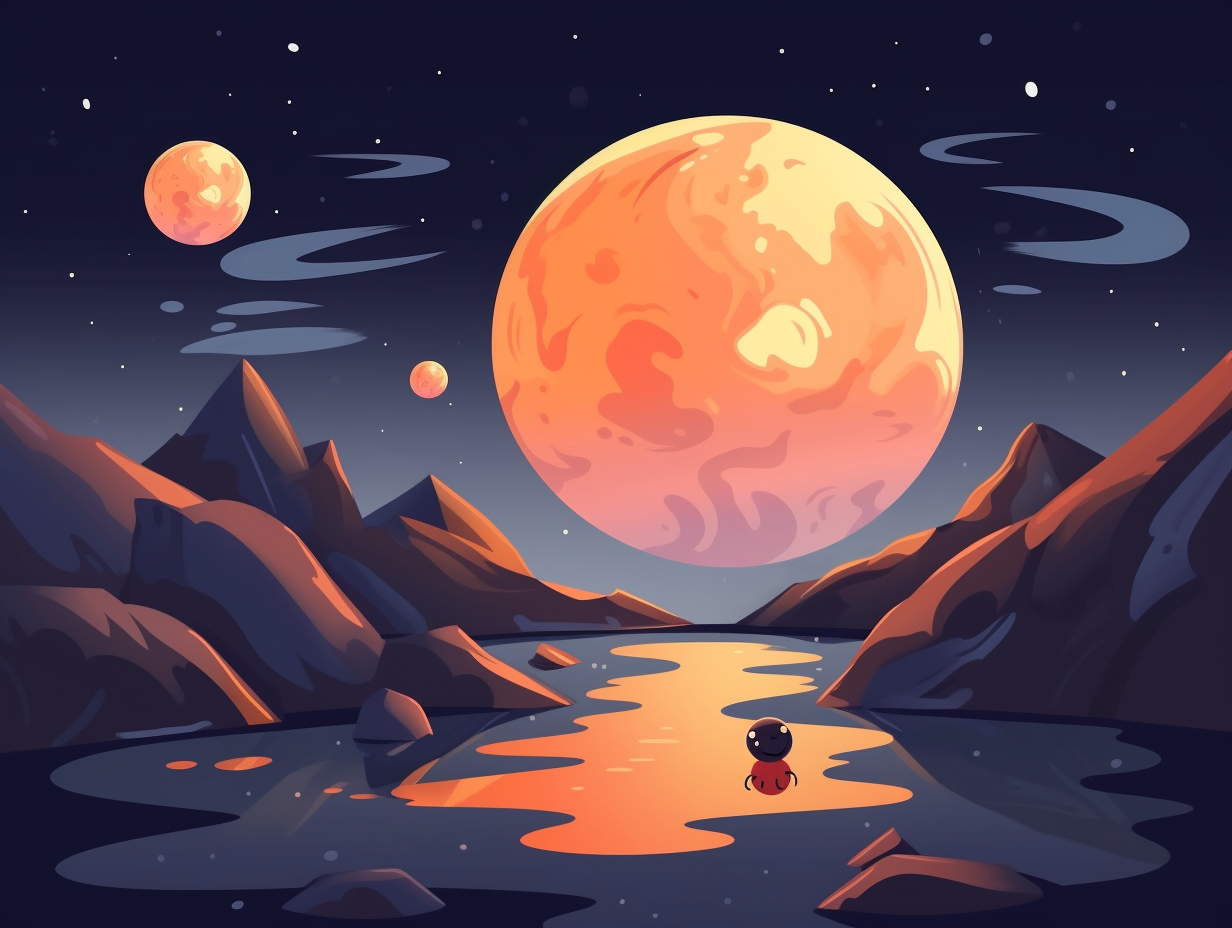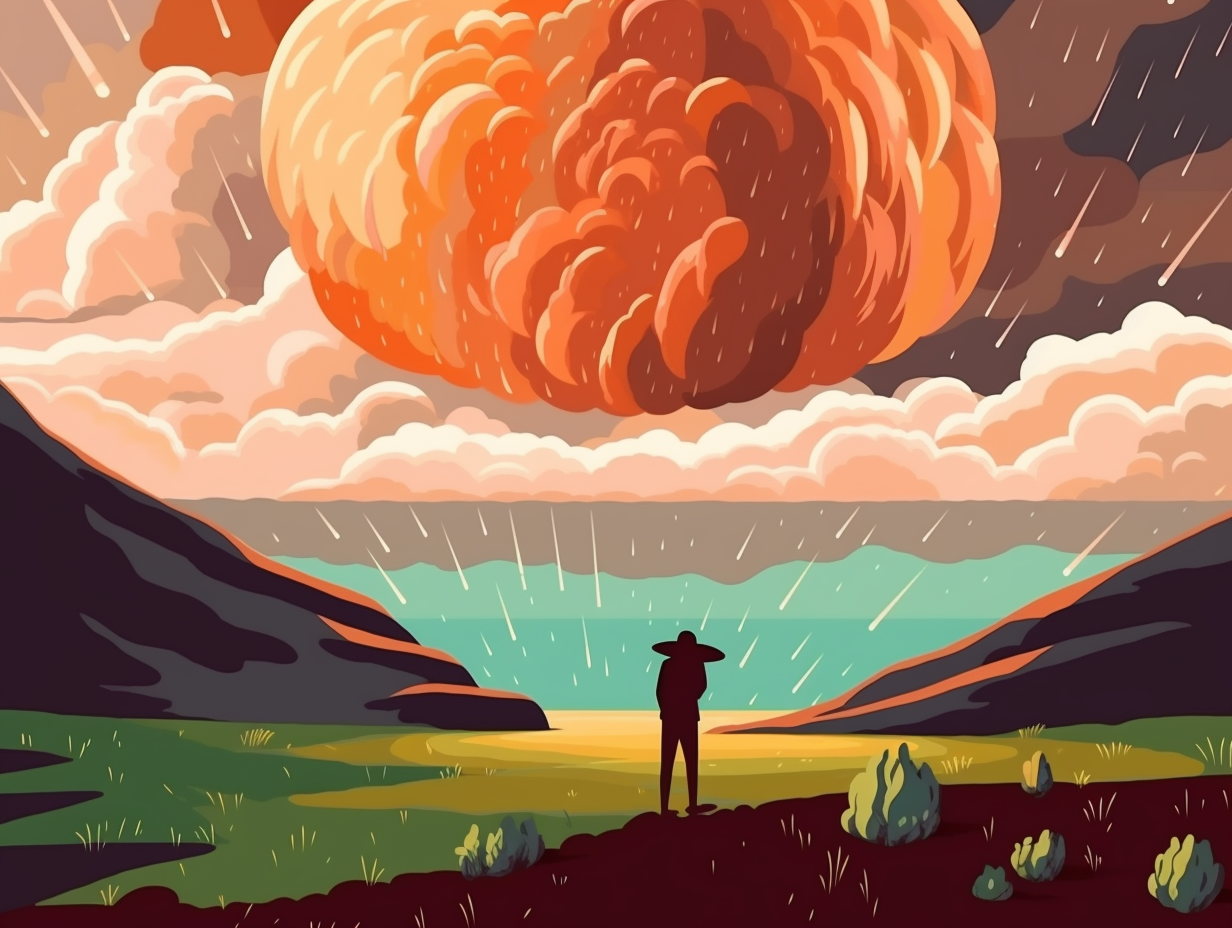Discover the Red Planet: Top 23 Engaging and Intriguing Fun Facts About Mars!

1. Valles Marineris: Grand Canyon on Steroids
If the Grand Canyon went to Mars and got bitten by a radioactive "size-does-matter" bug, it might turn into the mind-blowing Valles Marineris: An astonishing canyon system that's roughly 7 km deep and sprawls across the Martian equator for 4000 km (2500 mi), which is about as long as the United States but not ten times longer than the Grand Canyon as some liked to exaggerate.
Source => mars.nasa.gov
2. Mars' Tinder Bio: Dust Storm Enthusiast
If Mars had a Tinder bio, it would probably read, "Just a lonely red planet looking for some company, but beware, I've got a bit of a stormy side": Mars is famous for having the largest dust storms in our solar system, persisting for months and sometimes encompassing the entire planet. The red dust is primarily composed of iron, which reacts with the thin Martian atmosphere, creating the planet's distinct rusty hue.
Source => childrensmuseum.org

Did you know that Mars' moon Phobos is a master of celestial acrobatics? It orbits Mars so closely and quickly that it completes a full circuit in just 7 hours and 39 minutes, rising and setting twice in a single Martian day! 🌒💨 Discover more about this speedy satellite!
=> Fun Facts about Mars-Moons
3. Mars vs. Grand Canyon: The Battle of the Gorges
If the Grand Canyon ever threw a tantrum over being called "grandiosely gigantic", it would shrink in fear when faced with its Martian nemesis: Mars' Valles Marineris, the largest canyon in the Solar System, spans over 4,000 km in length and reaches up to 7 km in depth, giving it bragging rights of being 10 times longer and 4 times deeper than Arizona's famous gorge.
Source => spaceplace.nasa.gov
4. Phobos: Mars Moon With Commitment Issues
Fact or science fiction? Mars moon has serious commitment issues: Phobos, the larger of Mars' two moons, is slowly but surely creeping closer to the Red Planet, closing in at a rate of six feet (1.8 meters) every hundred years. In a dramatic celestial showdown, Phobos could either crash into Mars in about 50 million years or end up splintering into a planetary ring!
Source => solarsystem.nasa.gov

5. Cydonia: Home of Mysterious Mesas
While the "Face on Mars" turned out to be nothing more than a mesa after a close shave with reality, its neighbors sure know how to keep up that Cydonian mystique: Cydonia, where the misleading mug was spotted, houses numerous mesas and buttes that intrigue planetary geologists due to their location in the transition zone between cratered highlands and smoother lowland plains, suggesting a possible history of hosting Martian oceans.
Source => science.nasa.gov
6. Mars' Dry Ice Blankets and "Spiders"
Mars puts an extraterrestrial twist on Netflix and chill, by swapping warm blankets for blankets of dry ice: The Red Planet's polar ice caps are mainly composed of water ice and frozen carbon dioxide, which turns directly into gas during the warmer seasons, creating captivating spider-like channels and geysers without ever sizzling under the Martian sun.
Source => en.wikipedia.org
7. Subterranean Martian Getaway: Liquid Water
Who needs the beach when you can paddle on Mars? Scientists have found the perfect Martian getaway spot, complete with a subterranean pool: Recent findings indicate the existence of liquid water beneath the ice caps at Mars' southern pole, potentially a result of geothermal activity from recent magmatic happenings below the surface.
Source => space.com
8. Mars' Ancient Galactic Pool Party
Before Mars was the dry, Red Planet we consider it today, it must have thrown quite the galactic pool party: scientists have discovered evidence that Mars once had a large body of water, possibly an ocean, with features resembling ancient shorelines, erosion patterns, and water channels supporting this hypothesis.
Source => en.wikipedia.org
9. Mars' Circles of Insta-Sand Dunes
If Mars had a reality show, it would be called “Mars' Next Top Sand Dune”: Scientists have discovered near-perfect circular sand dunes on the Red Planet's surface, which is quite rare in the Martian world of less-than-perfect dunes! The serious reveal: Using a high-resolution camera orbiting Mars, scientists have been able to monitor these sand dunes in detail and observe their movements, further uncovering a variety of dune sizes and shapes that provide insight into the planet's weather conditions.
Source => space.com

10. A Martian Snow-pocalypse Awaits
Forget your earthly snowball fights, gather your interplanetary snow-troopers, and prepare for a Martian snow-pocalypse: Recent studies have found that Mars may experience a unique version of snow called a microburst, where rapid downdrafts carry ice crystals at speeds of up to 10 meters per second, potentially leaving a fleeting layer of snow on the red planet's surface.
Source => phys.org
11. Mars' Dust Storm Raves
If Mars had a dance floor, it'd be a hotbed for the most gargantuan, rowdy, and long-lasting dust parties this side of the Milky Way: With dust storms that can last for months and ascend to staggering heights of 60 km (37 miles), Mars showcases some of the most epic meteorological raves in the solar system, often leading to a planetary-scale dust-induced blackout.
Source => nasa.gov
12. Mars' Bi-Polar Fashion Statement
Mars: where "sweater weather" takes on a whole new meaning! With scorching summer afternoons that can make you ditch your space parka and frigid nights that'll freeze your socks off, the Red Planet really knows how to keep you on your (fashionable) toes: The average temperature on Mars is -80°F, but it can get as warm as 70°F near the equator during summers, while nighttime temperatures can plunge to a bone-chilling -100°F.
Source => space.com
13. Mount Olympus Mons: Everest's Overachiever
Call it Mount Everest's overachieving cousin with an out-of-this-world address: Olympus Mons, a shield volcano on Mars, covers an area comparable to Arizona and stands at a monstrous 13.6 miles (22 kilometers) tall, making it the solar system's tallest volcano and more than doubling Everest's height.
Source => reddit.com
14. Gentle Martian Breezes at 60mph
Hold onto your hats... or maybe not! Experiencing a 60 mph wind gust on Mars feels like a gentle, Earthly 7.7 mph breeze: This is because the air density on Mars is a mere 0.020 kg/m³, compared to Earth's sea-level density of 1.225 kg/m³, making a 60 mph Martian wind exert a pressure of just 7.192 Pa—barely enough to ruffle your hair.
Source => space.stackexchange.com

15. Mars' Daytime Aurora Parties
If Martian skies could talk, they'd boast about their flashy daytime aurora parties that put Earth's nighttime light shows to shame: The auroras on Mars, observed by NASA's MAVEN mission, can cover the entire planet and are visible even during the day due to particles from solar storms interacting with its weak magnetic field, leading to its atmosphere being stripped away by the sun.
Source => pbs.org
16. Mars: The Cosmic Watermelon and Blue Sunsets
Mars, the cosmic watermelon of the galaxy: Its reddish exterior may try to pass it off as a big ripe fruit, but iron oxide is to blame for its famous rouge appearance. This rusty dust coating not only gives Mars its nickname, the Red Planet, but also adds an unexpected twist to sunsets at the Martian horizon - they appear bluish to human eyes as the dusky atmosphere scatters the blue light, enhancing the sky while other colors retreat. So, Martian sunsets are both visually enchanting and scientifically tantalizing, helping researchers examine the dusty Martian veil and hunt for elusive ice clouds.
Source => solarsystem.nasa.gov
17. How Martians See Earth: Two Shining Stars
When Martians enjoy an "Earth Day" with their own little green fingers raised to the sky, they see a dazzling sight: On the 529th Martian day of the Curiosity rover's expedition, it captured an image of Earth and the moon, visible as two bright evening stars from the surface of Mars.
Source => foxnews.com
18. Prunes: Astronauts' Super Space Snack
Bone loss got astronauts feeling like plums out of this world? Well, they could soon be relying on a prune-tastic space snack to keep their skeleton strong: Researchers have found that consuming dried plums, aka prunes, can help counter bone density loss experienced by astronauts who endure 6-9% loss from their hips after six months in space, which is the same amount a postmenopausal woman loses annually on Earth.
Source => ucsf.edu
19. Mars: Working on its Core Strength
Hold on to your hats, folks, because it turns out Mars has been hitting the gym: its core is actually quite dense, filled with a concoction of lighter elements! The serious reveal: A recent study based on NASA's InSight lander data discovered Mars' core comprises about 20% lighter elements like sulfur, oxygen, carbon, and hydrogen, and measures around 2,212-2,249 miles (3,560-3,620 km) in diameter—slightly tinier than previously thought. Strong and compact, Mars sure knows how to maintain its core strength!
Source => reuters.com
20. Mars' Late Heavy Bombardment Meteorite Ragers
Ladies and gentlemen, hold onto your helmets as we journey back to a time when Mars threw the wildest meteorite ragers in the solar system: During its "late heavy bombardment" phase around 3.8 to 3.9 billion years ago, Mars experienced a higher rate of impacts from leftover material from planet formation compared to Earth, although both planets hosted these celestial fiestas around the same time.
Source => space.com
21. Phobos and Deimos: Mars' Quirky Companions
Move over, relationship status—it's complicated. Say hello to Mars' two quirky companions: Mars is orbited by a couple of captured asteroids called Phobos and Deimos, with Phobos being a darker, less reflective oddball that sits closer, while Deimos maintains its distance in a more stable outer orbit. Studied and explored by space agencies far and wide, these two oddities keep things interesting in our planetary neighborhood.
Source => solarsystem.nasa.gov
22. Mars: Life of the Planetary Party Turned Cold
Once upon a time, Mars was the life of the solar system party: it was wetter, warmer, and flaunted its attractive atmosphere. But like all good things, these glory days came to a bitter end. Little did we know: Mars was once a potentially habitable environment, with water and a thicker atmosphere, thus sparking scientific curiosity in exploring its surface for clues about its history and the evolution of our neighboring celestial bodies.
Source => esa.int
23. Martian Bling: Playground for Gold Diggers
If you ever find yourself on Mars with a sudden urge to splurge on some bling, don't fret: Mars' mantle is rich in noble metals such as gold, platinum, and iridium, thanks to a massive impact over four billion years ago during Mars' late accretion period.
Source => astrobiology.nasa.gov
Related Fun Facts




















